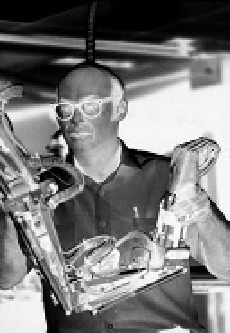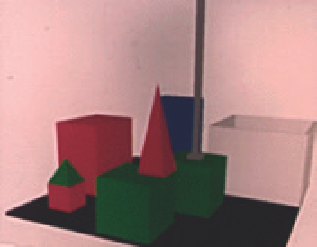Information Technology Reference
In-Depth Information
environment and what is wanted from it. To make these statements will require
little if any knowledge of the program or the previous knowledge of the advice
taker. One will be able to assume that the advice taker will have available to it a
fairly wide class of immediate logical consequences of anything it is told and its
previous knowledge. This property is expected to have much in common with
what makes us describe certain humans as having common sense. We shall
therefore say that a program has common sense if it automatically deduces for
itself a sufficiently wide class of immediate consequences of anything it is told
and what it already knows.
11
Advice Taker embodied the idea that an AI system needed an explicit represen-
tation of the world and the ability to manipulate this knowledge with logical
deductive processes. This vision set the agenda for AI research for the next few
decades.
Marvin Minsky (
B.13.6
) arrived at MIT at the same time as McCarthy,
and together they set up the MIT Artificial Intelligence Laboratory. Their
research collaboration lasted only a few years before their approaches to
AI diverged. Minsky concentrated on just getting systems to do interesting
things - “scruffy AI.” Minsky's students focused on solving problems in very
limited
domains
, application areas not requiring a broad general knowledge.
Successful examples included the domains of integral calculus, geometry,
and algebra as well as a famous series of problems in the “blocks world”
(
Fig. 13.4
), a simplified world consisting of some toy blocks sitting on a table.
SHRDLU, developed by Terry Winograd, was a computer program that could
understand instructions and carry on conversations about the blocks world.
Unlike Minsky, McCarthy emphasized knowledge representations and rea-
soning using formal logic. In 1963 McCarthy left MIT to start the Stanford
Artificial Intelligence Laboratory.
As computers became more powerful and as computer memories became
larger, there was a movement for researchers to explicitly build “knowledge”
into AI applications and to develop
expert systems
, computer programs that imi-
tate the decision making of a human expert. One of the pioneers of the expert-
systems approach to AI was Ed Feigenbaum (
B.13.7
) at Stanford University. In
1969, with Bruce Buchanan and Joshua Lederberg, a geneticist and recipient of
the Nobel Prize, Feigenbaum developed the DENDRAL program that attempted
to capture the expert knowledge of chemists and to apply that knowledge by
employing a set of rules. The name DENDRAL was an abbreviation of
dendritic
algorithm
,
dendritic
referring to the branching fibers of neurons that pick up nerve
impulses. The problem that DENDRAL attempted to solve was that of determin-
ing the molecular structure of a substance using data provided by a mass spec-
trometer, an instrument that separates particles of different masses in a similar
way to light spread out into different colors by a prism. To identify the precise
structure of a compound, a chemist must deduce its chemical elements from the
set of masses of fragments of the compound. For large molecules, this generates
a huge number of possible structures. To make the problem manageable, expert
chemists use their own rules of thumb - in other words,
heuristics
- to recognize
well-known substructures and thereby reduce the number of possibilities for the
overall structure of the compound. DENDRAL combined a knowledge base, writ-
ten in the form of rules, with a reasoning engine written in Lisp. DENDRAL was
Fig. 13.4. The SHRDLU “blocks world”
program was written by Terry Winograd
at MIT. The program could understand
and execute instructions given in natu-
ral language to move different types of
blocks around in a virtual box.
B.13.6. Marvin Minsky is one of
the original pioneers of AI. He is
also credited with the invention of
the first head-mounted graphical
display in 1963. He also acted as
a scientific adviser for Stanley
Kubrick's film
2001: A Space Odyssey
.
Science fiction writer Isaac Asimov
described Minsky as one of only
two people he would admit were
smarter than he was. The other
was cosmologist and astronomer
Carl Sagan.


Search WWH ::

Custom Search